Презентація на тему «Music Appreciation»
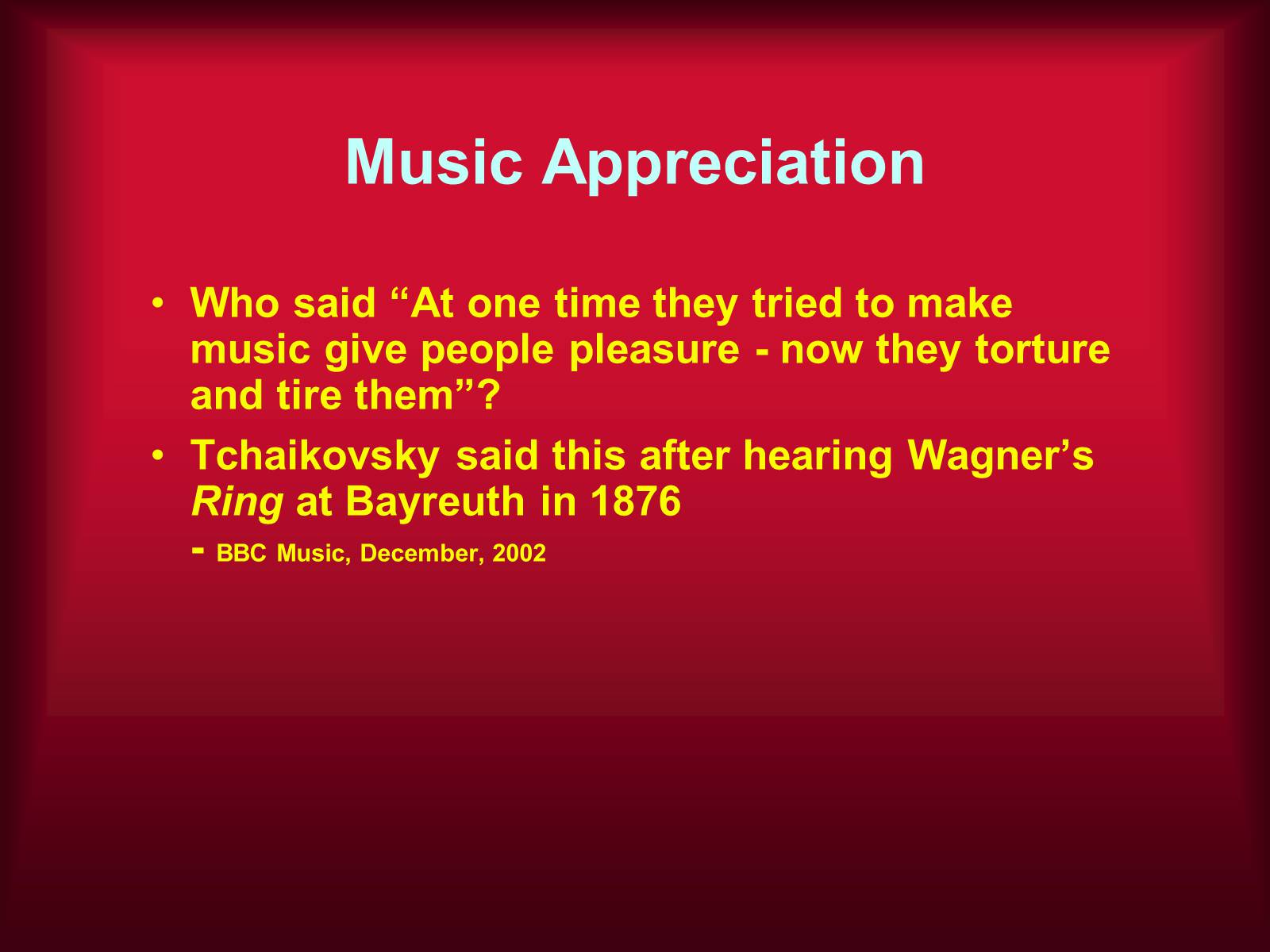
Music Appreciation
Who said “At one time they tried to make music give people pleasure - now they torture and tire them”?
Tchaikovsky said this after hearing Wagner's Ring at Bayreuth in 1876- BBC Music, December, 2002

Music Appreciation
Who said “At one time they tried to make music give people pleasure - now they torture and tire them”?
Tchaikovsky said this after hearing Wagner's Ring at Bayreuth in 1876- BBC Music, December, 2002
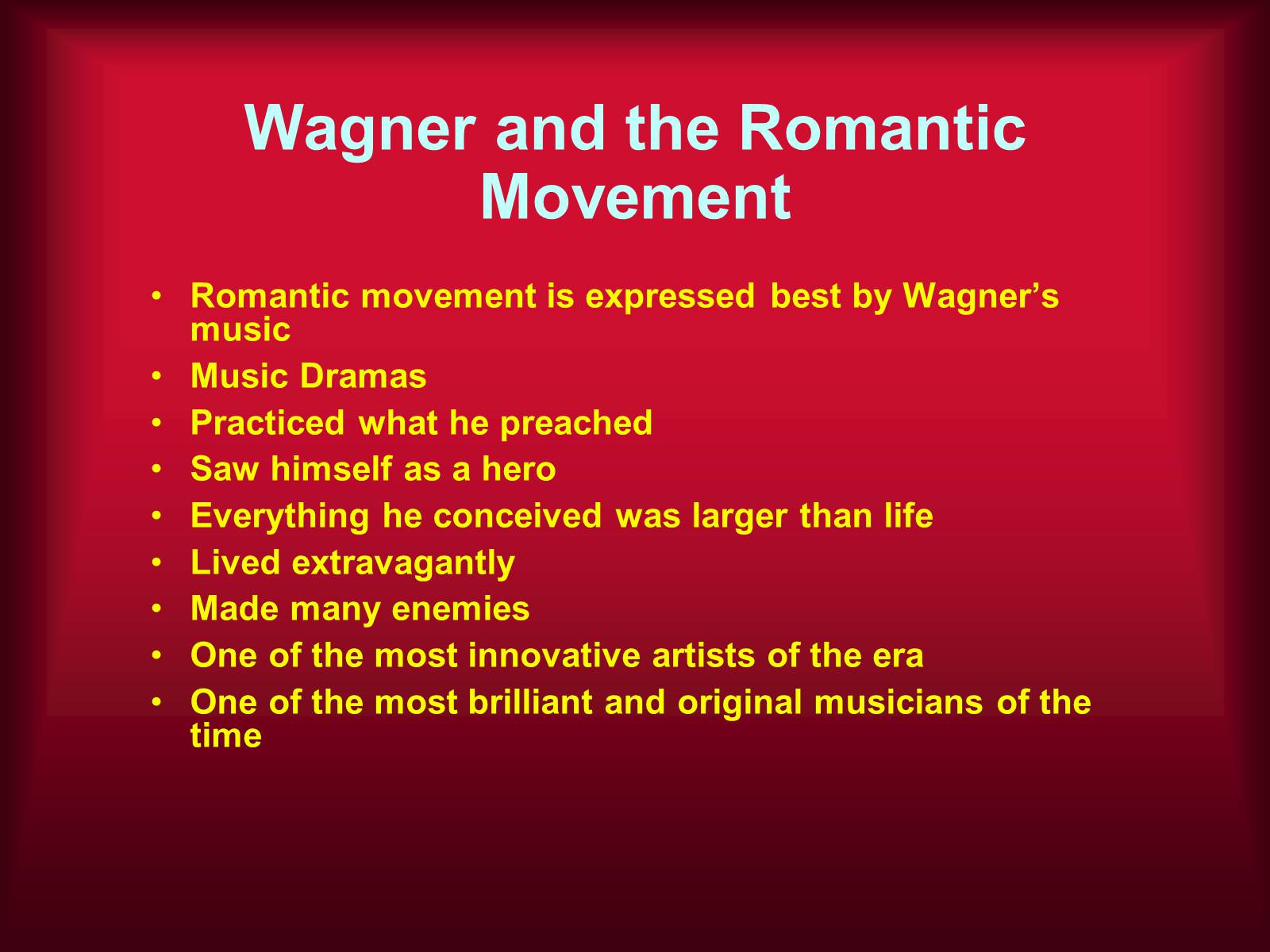
Wagner and the Romantic Movement
Romantic movement is expressed best by Wagner's music
Music Dramas
Practiced what he preached
Saw himself as a hero
Everything he conceived was larger than life
Lived extravagantly
Made many enemies
One of the most innovative artists of the era
One of the most brilliant and original musicians of the time
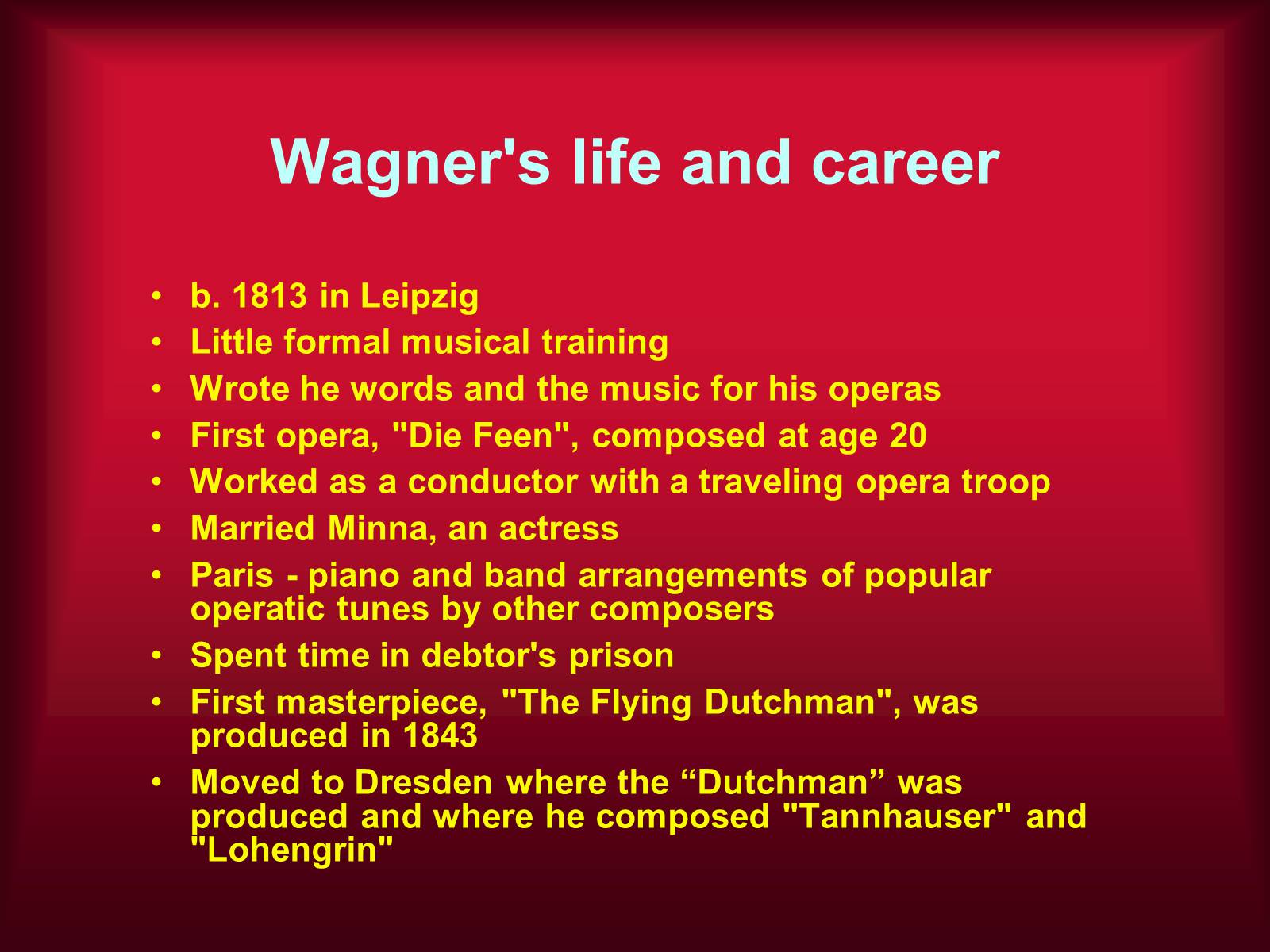
Wagner's life and career
b. 1813 in Leipzig
Little formal musical training
Wrote he words and the music for his operas
First opera, "Die Feen", composed at age 20
Worked as a conductor with a traveling opera troop
Married Minna, an actress
Paris - piano and band arrangements of popular operatic tunes by other composers
Spent time in debtor's prison
First masterpiece, "The Flying Dutchman", was produced in 1843
Moved to Dresden where the “Dutchman” was produced and where he composed "Tannhauser" and "Lohengrin"
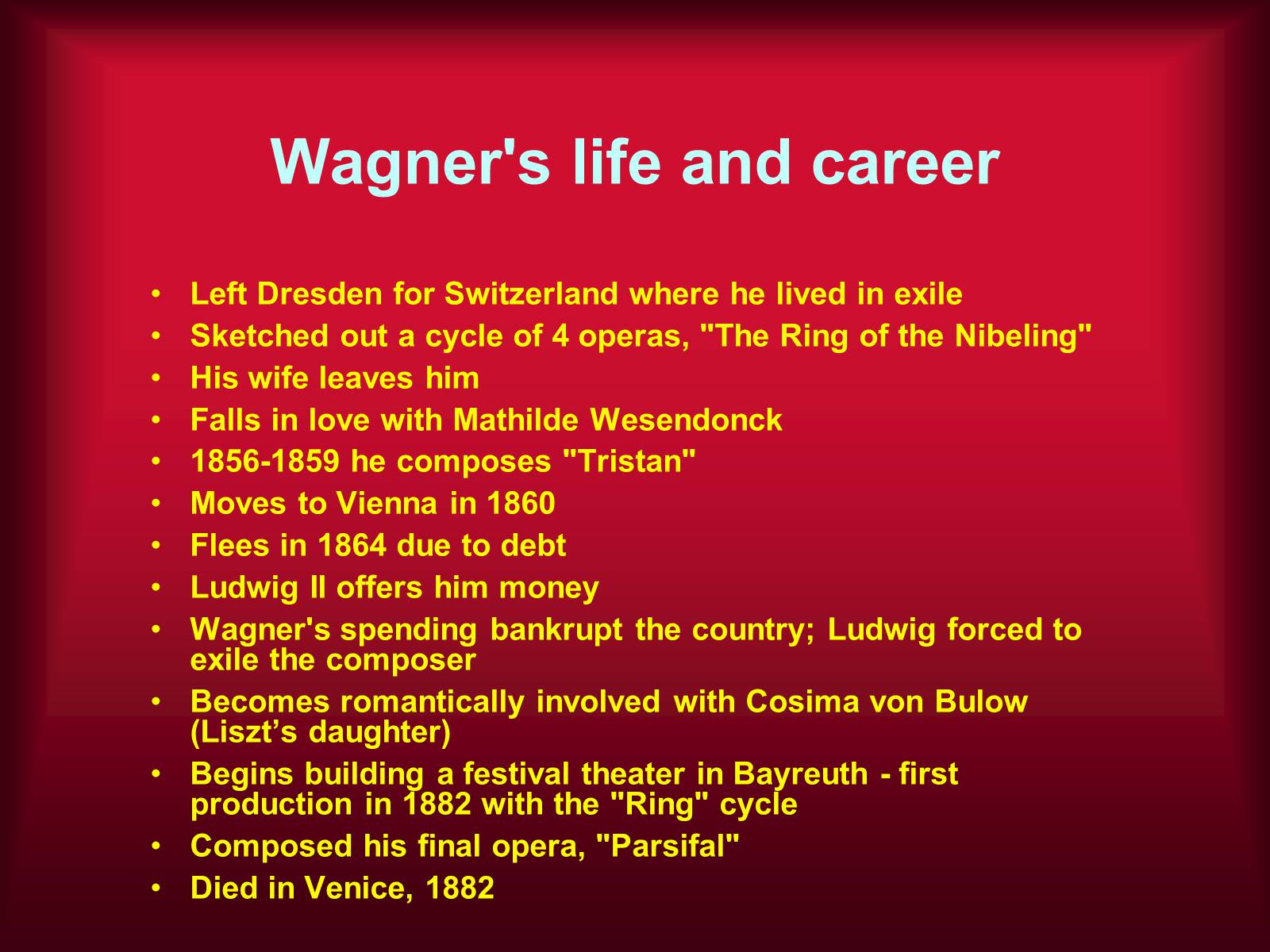
Wagner's life and career
Left Dresden for Switzerland where he lived in exile
Sketched out a cycle of 4 operas, "The Ring of the Nibeling"
His wife leaves him
Falls in love with Mathilde Wesendonck
1856-1859 he composes "Tristan"
Moves to Vienna in 1860
Flees in 1864 due to debt
Ludwig II offers him money
Wagner's spending bankrupt the country; Ludwig forced to exile the composer
Becomes romantically involved with Cosima von Bulow (Liszt's daughter)
Begins building a festival theater in Bayreuth - first production in 1882 with the "Ring" cycle
Composed his final opera, "Parsifal"
Died in Venice, 1882
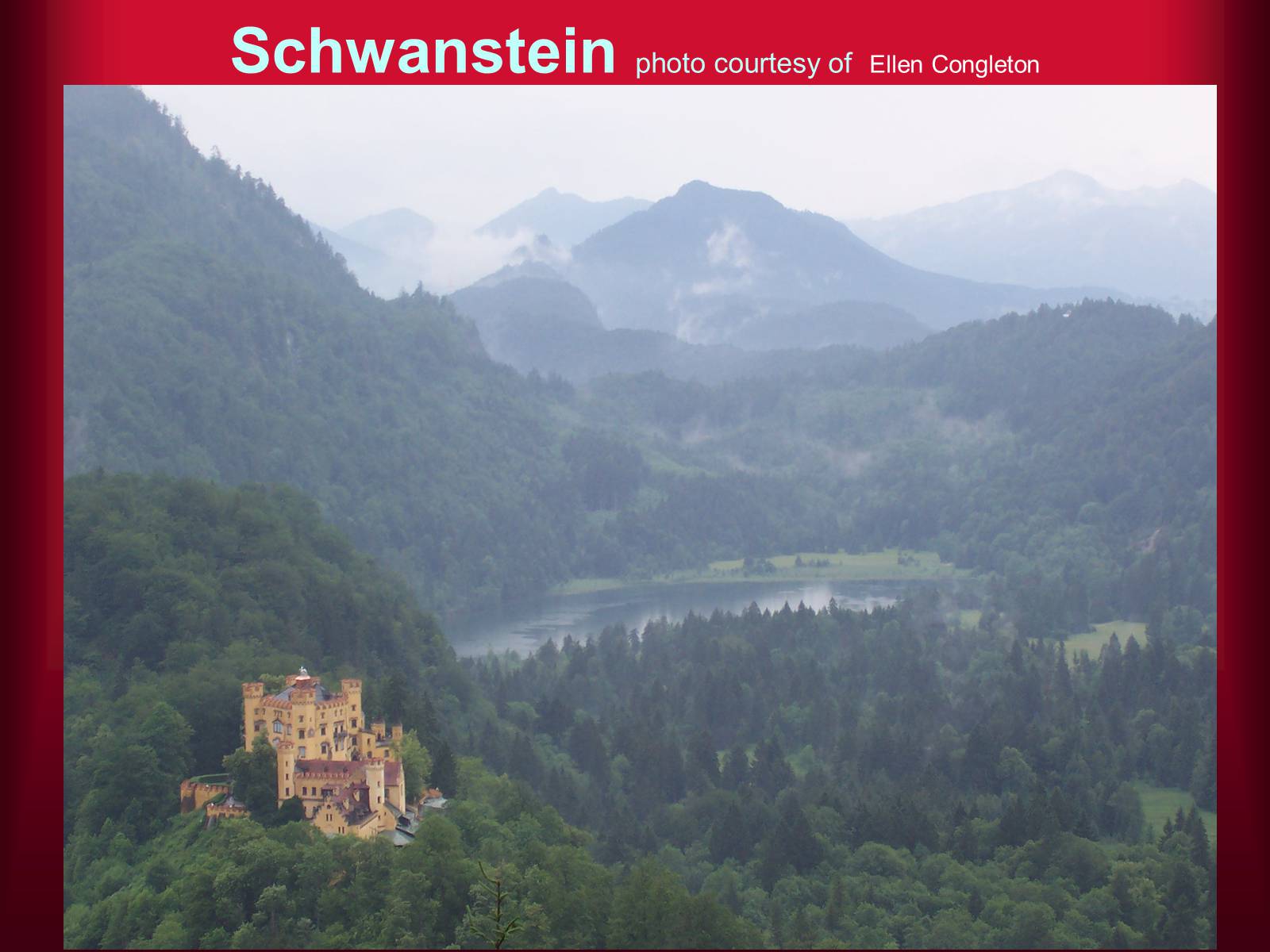
Schwanstein photo courtesy of Ellen Congleton
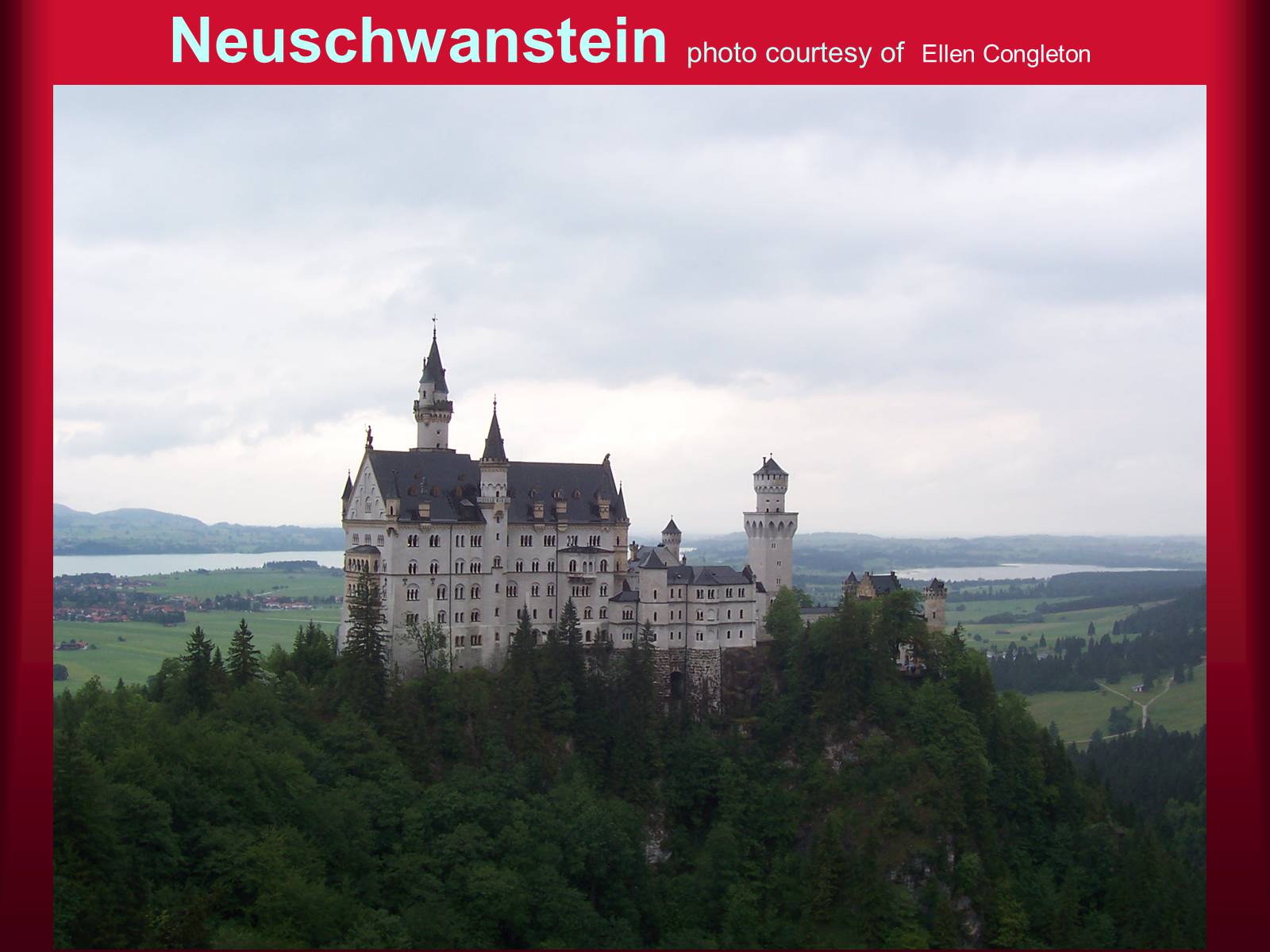
Neuschwanstein photo courtesy of Ellen Congleton

The "Complete Work of Art"
Wagner believed that art and opera must be more than a diversion
His idea is called Gesamtkunstwerk
Totally revolutionized Harmony by completely avoiding resolution with known, stable chords
Orchestra is important now
Constructed scores with a symphonic sound in mind
The singing becomes an instrument in the overall effect
Expanded the size of the orchestra
Invented new instruments (the Wagner tuba)
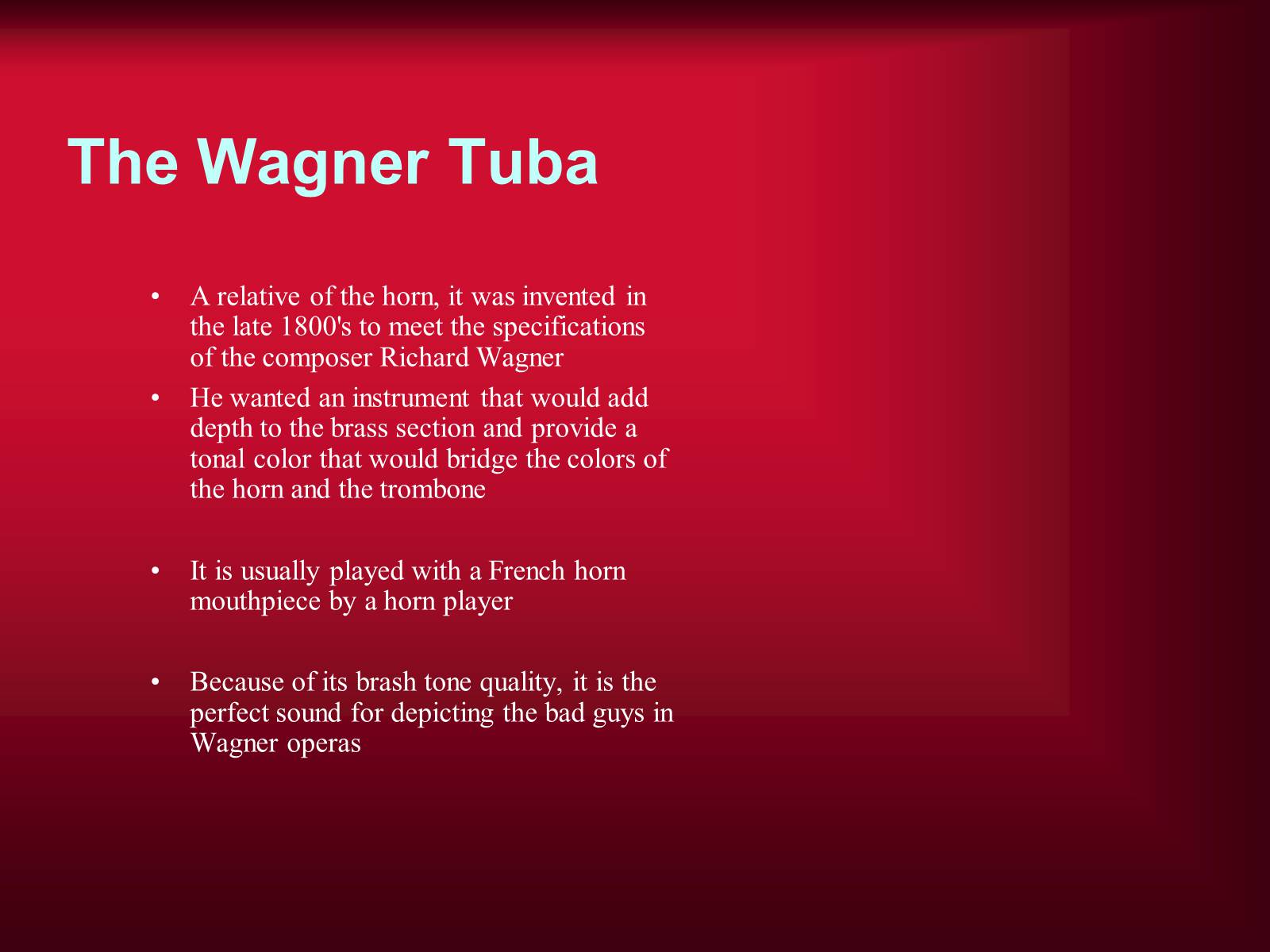
The Wagner Tuba
A relative of the horn, it was invented in the late 1800's to meet the specifications of the composer Richard Wagner
He wanted an instrument that would add depth to the brass section and provide a tonal color that would bridge the colors of the horn and the trombone
It is usually played with a French horn mouthpiece by a horn player
Because of its brash tone quality, it is the perfect sound for depicting the bad guys in Wagner operas
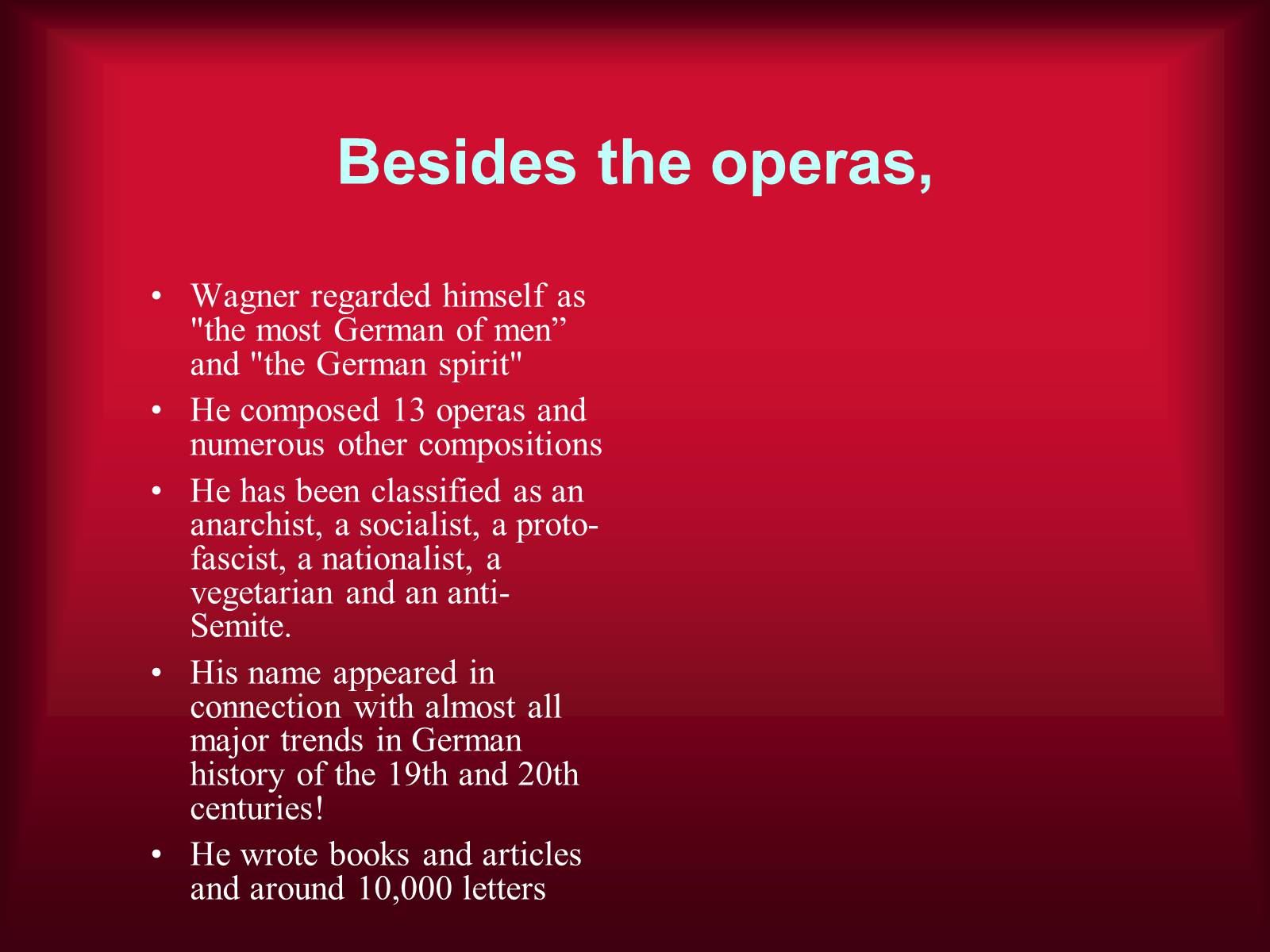
Besides the operas,
Wagner regarded himself as "the most German of men” and "the German spirit"
He composed 13 operas and numerous other compositions
He has been classified as an anarchist, a socialist, a proto-fascist, a nationalist, a vegetarian and an anti-Semite.
His name appeared in connection with almost all major trends in German history of the 19th and 20th centuries!
He wrote books and articles and around 10,000 letters

Wagner's Family Tree
Parents:
Carl Friedrich Wilhelm Wagner (1770-1813), Richard's real father was probably Ludwig Geyer
Johanne Pätz (1774-1848)
First Wife:
Minna Planer (1809-1865), no children
Second Wife:
Cosima von Bülow (1837-1930, the daughter of Franz Liszt), two children with Hans von Bülow and three children with Richard Wagner
Children:
Isolde (1865-1919), married to Franz Beidler
Eva (1867-1942), married to Houston Stewart Chamberlain
Siegfried (1869-1930), married to Winifred Williams Klindworth (1897-1980)
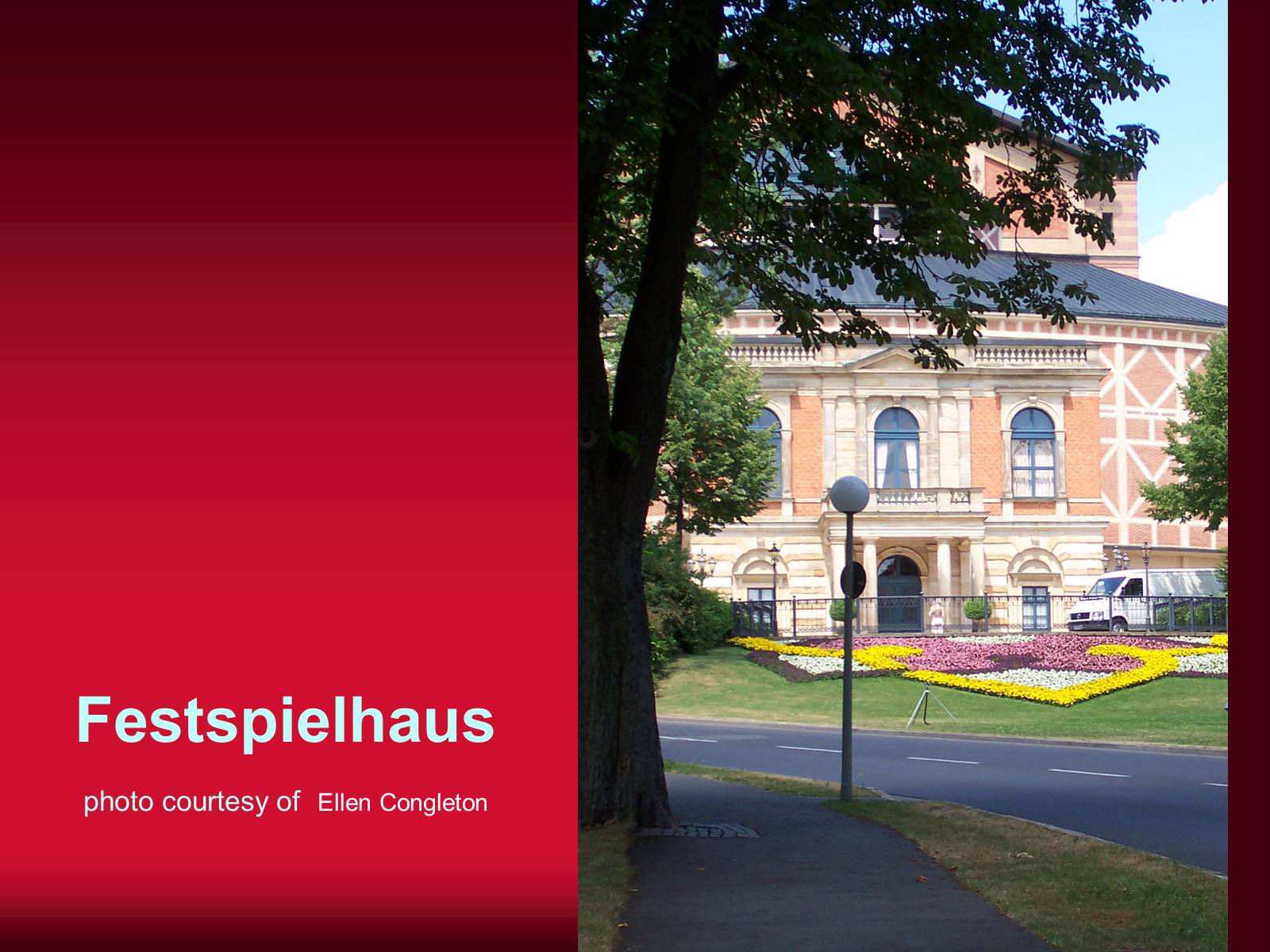
Festspielhaus photo courtesy of Ellen Congleton

Outside Wagner's Home photo courtesy of Ellen Congleton
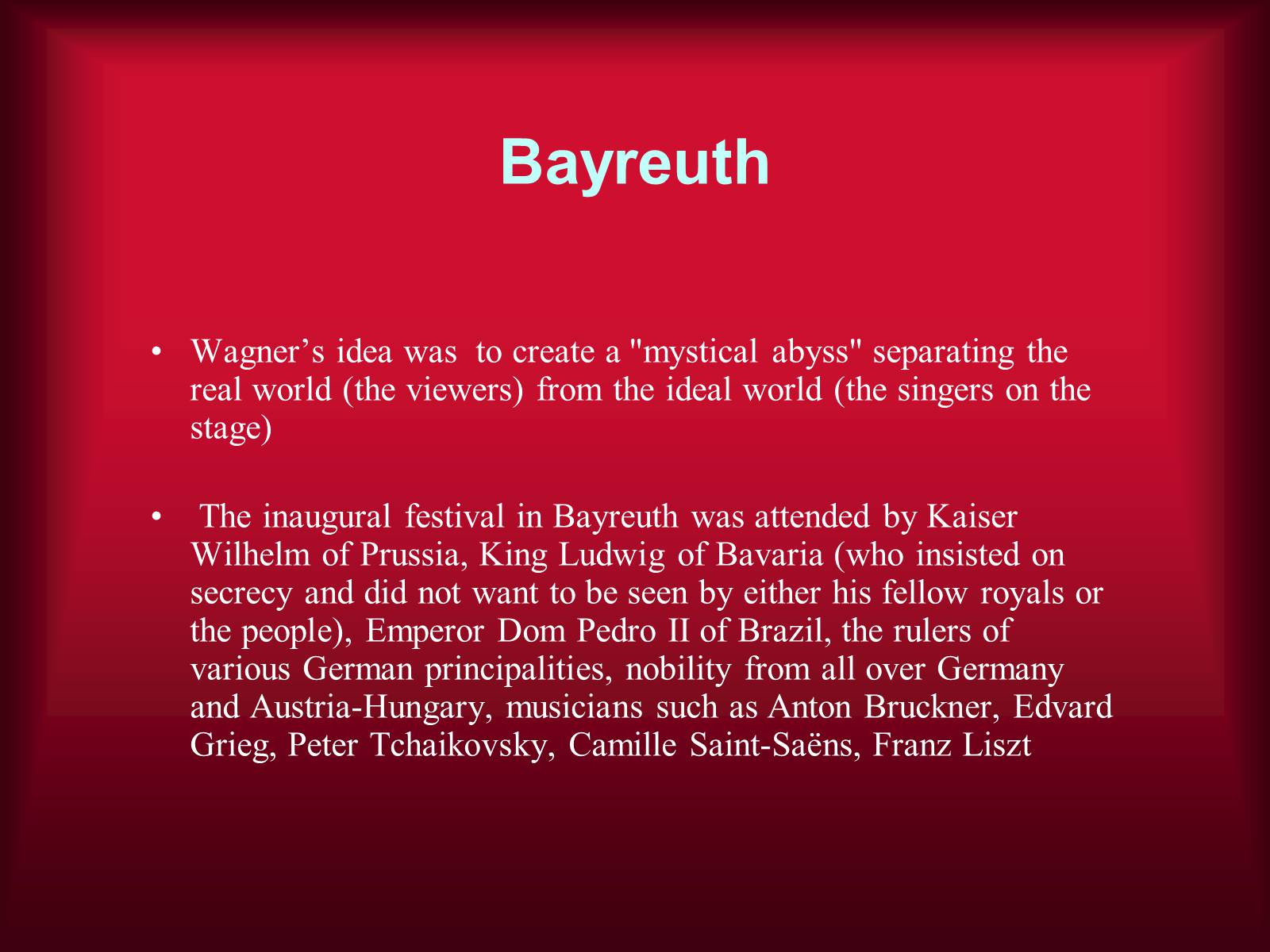
Bayreuth
Wagner's idea was to create a "mystical abyss" separating the real world (the viewers) from the ideal world (the singers on the stage)
The inaugural festival in Bayreuth was attended by Kaiser Wilhelm of Prussia, King Ludwig of Bavaria (who insisted on secrecy and did not want to be seen by either his fellow royals or the people), Emperor Dom Pedro II of Brazil, the rulers of various German principalities, nobility from all over Germany and Austria-Hungary, musicians such as Anton Bruckner, Edvard Grieg, Peter Tchaikovsky, Camille Saint-Saëns, Franz Liszt
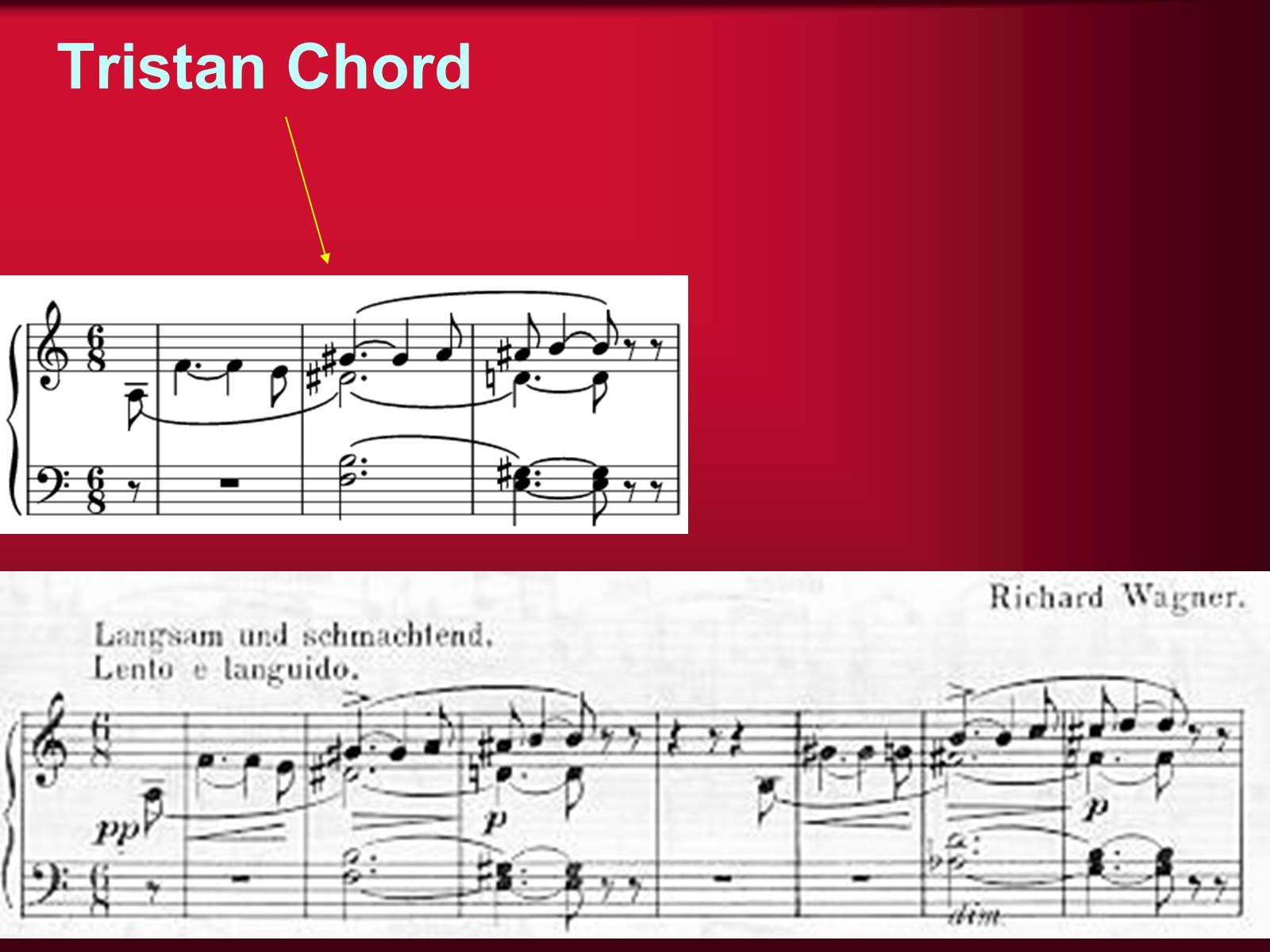
Tristan Chord
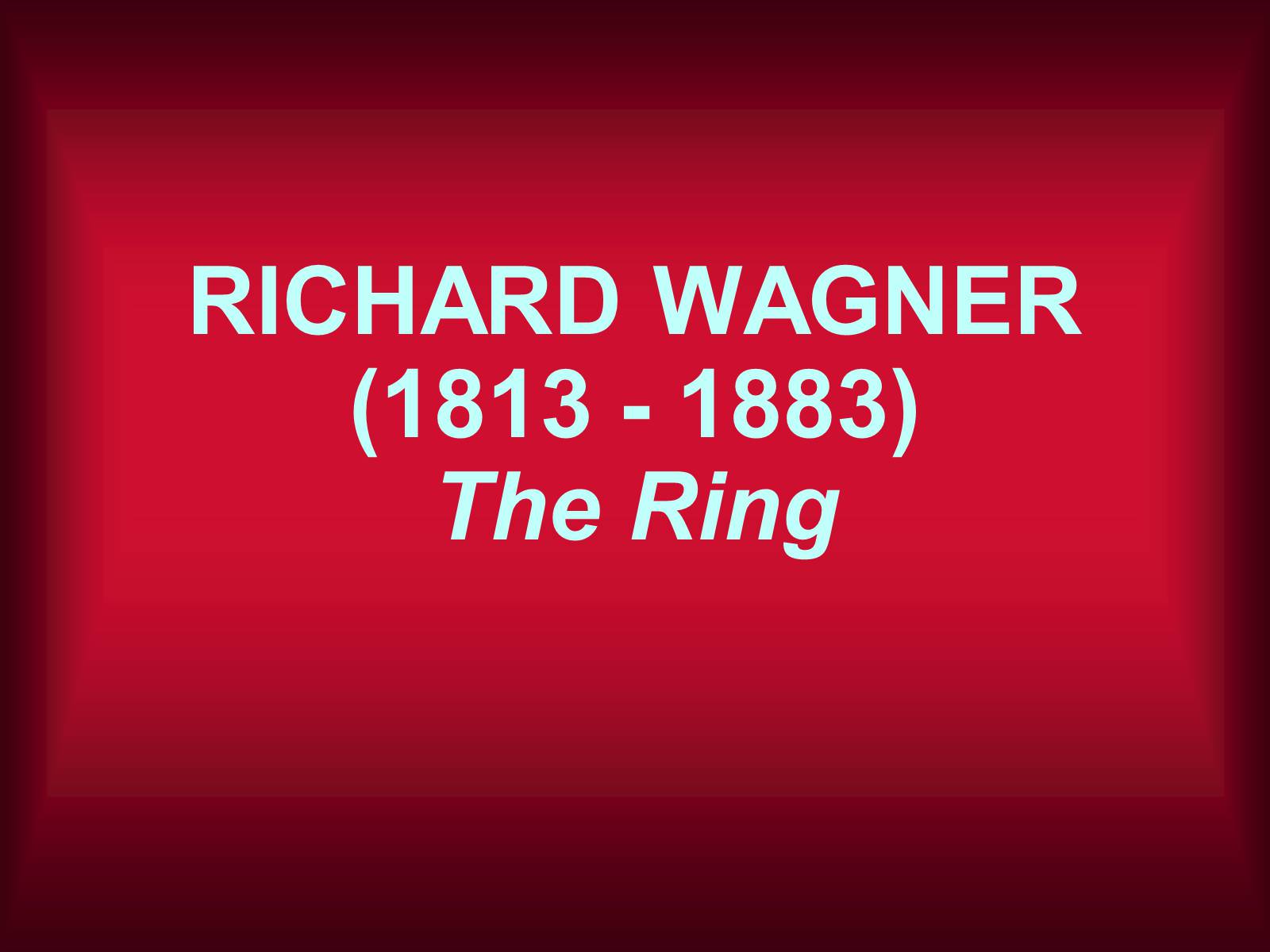
RICHARD WAGNER(1813 - 1883)The Ring
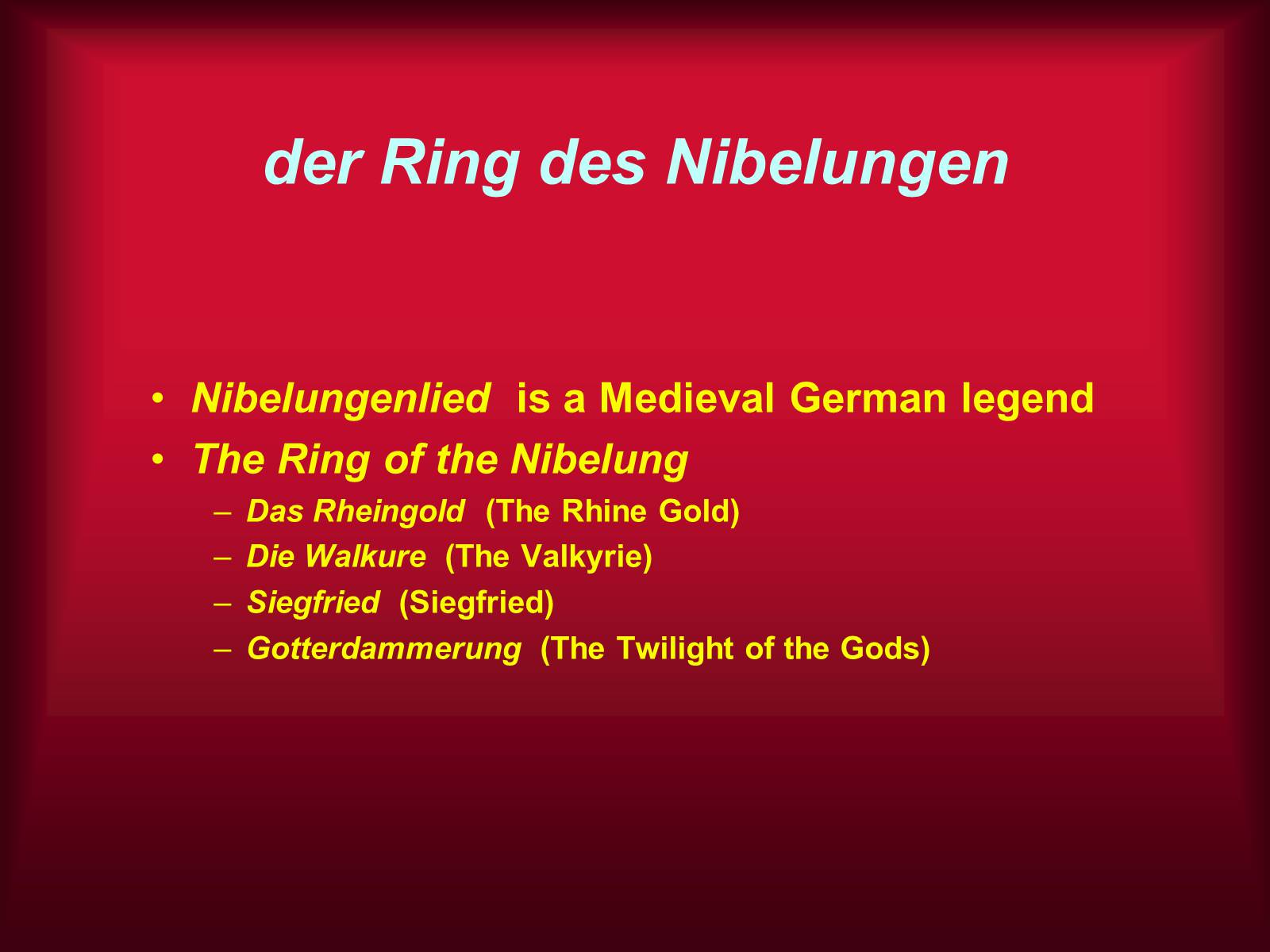
der Ring des Nibelungen
Nibelungenlied is a Medieval German legend
The Ring of the Nibelung
Das Rheingold (The Rhine Gold)
Die Walkure (The Valkyrie)
Siegfried (Siegfried)
Gotterdammerung (The Twilight of the Gods)
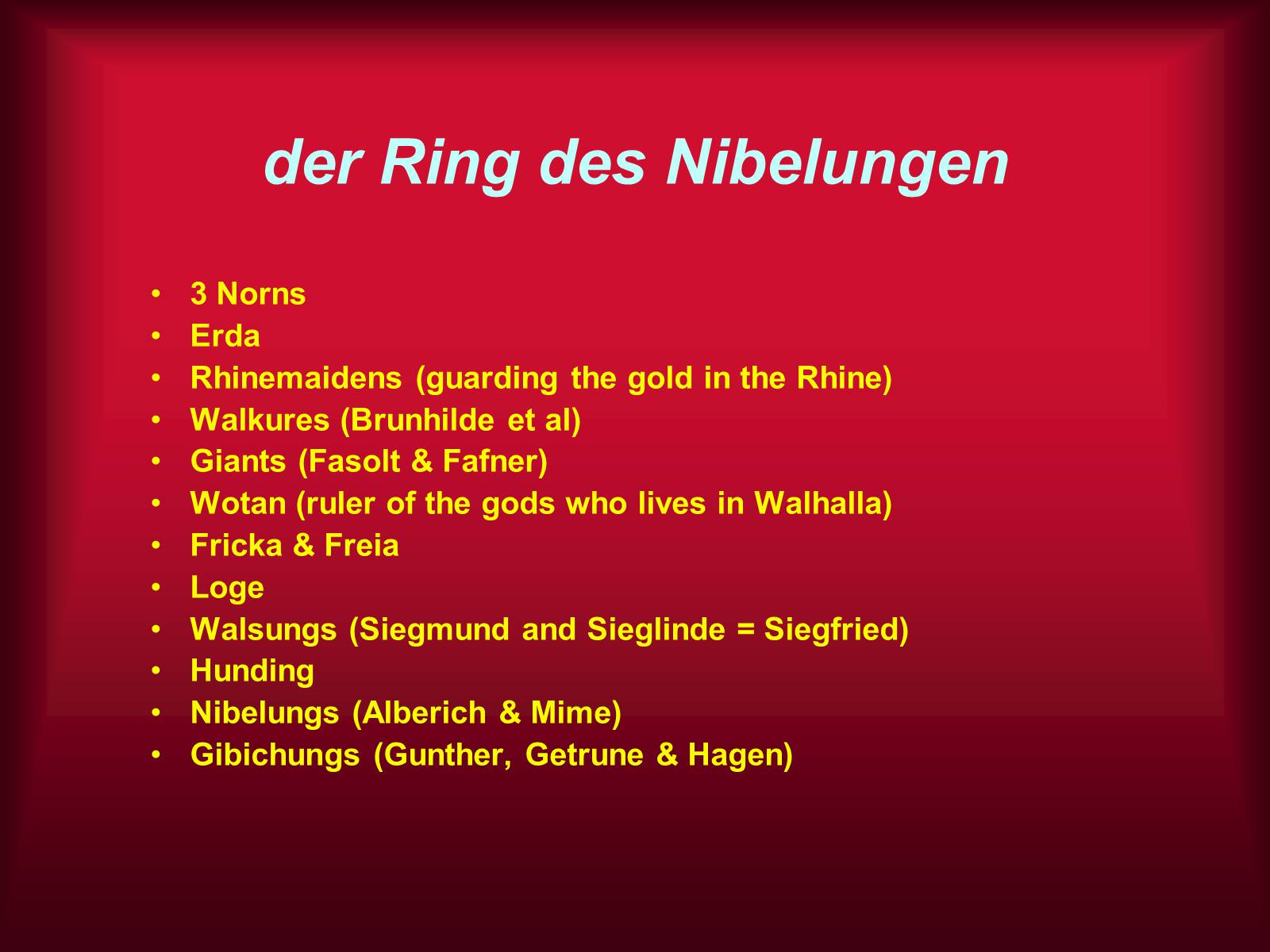
der Ring des Nibelungen
3 Norns
Erda
Rhinemaidens (guarding the gold in the Rhine)
Walkures (Brunhilde et al)
Giants (Fasolt & Fafner)
Wotan (ruler of the gods who lives in Walhalla)
Fricka & Freia
Loge
Walsungs (Siegmund and Sieglinde = Siegfried)
Hunding
Nibelungs (Alberich & Mime)
Gibichungs (Gunther, Getrune & Hagen)
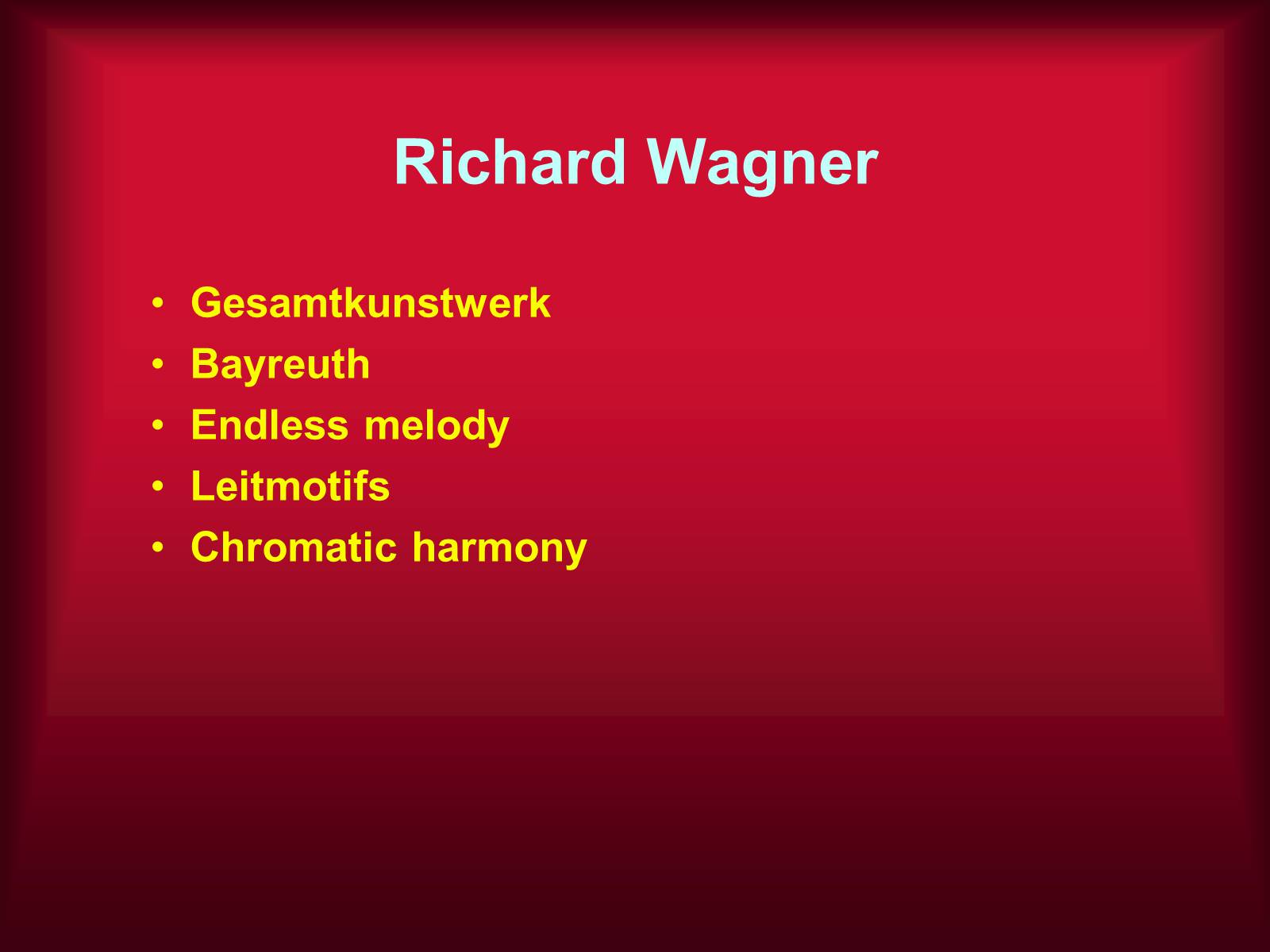
Richard Wagner
Gesamtkunstwerk
Bayreuth
Endless melody
Leitmotifs
Chromatic harmony
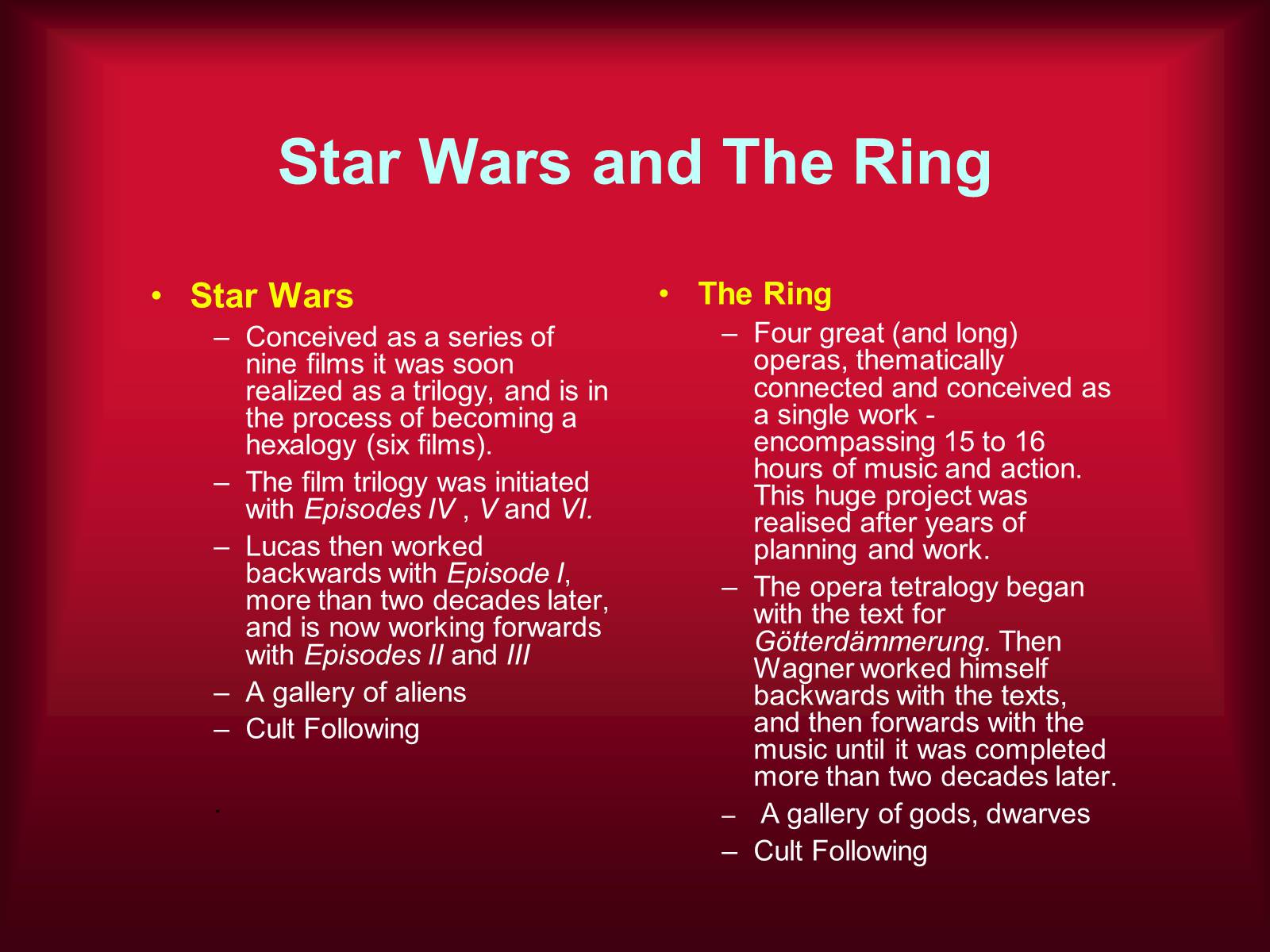
Star Wars and The Ring
Star Wars
Conceived as a series of nine films it was soon realized as a trilogy, and is in the process of becoming a hexalogy (six films).
The film trilogy was initiated with Episodes IV , V and VI.
Lucas then worked backwards with Episode I, more than two decades later, and is now working forwards with Episodes II and III
A gallery of aliens
Cult Following
.
The Ring
Four great (and long) operas, thematically connected and conceived as a single work - encompassing 15 to 16 hours of music and action. This huge project was realised after years of planning and work.
The opera tetralogy began with the text for Götterdämmerung. Then Wagner worked himself backwards with the texts, and then forwards with the music until it was completed more than two decades later.
A gallery of gods, dwarves
Cult Following
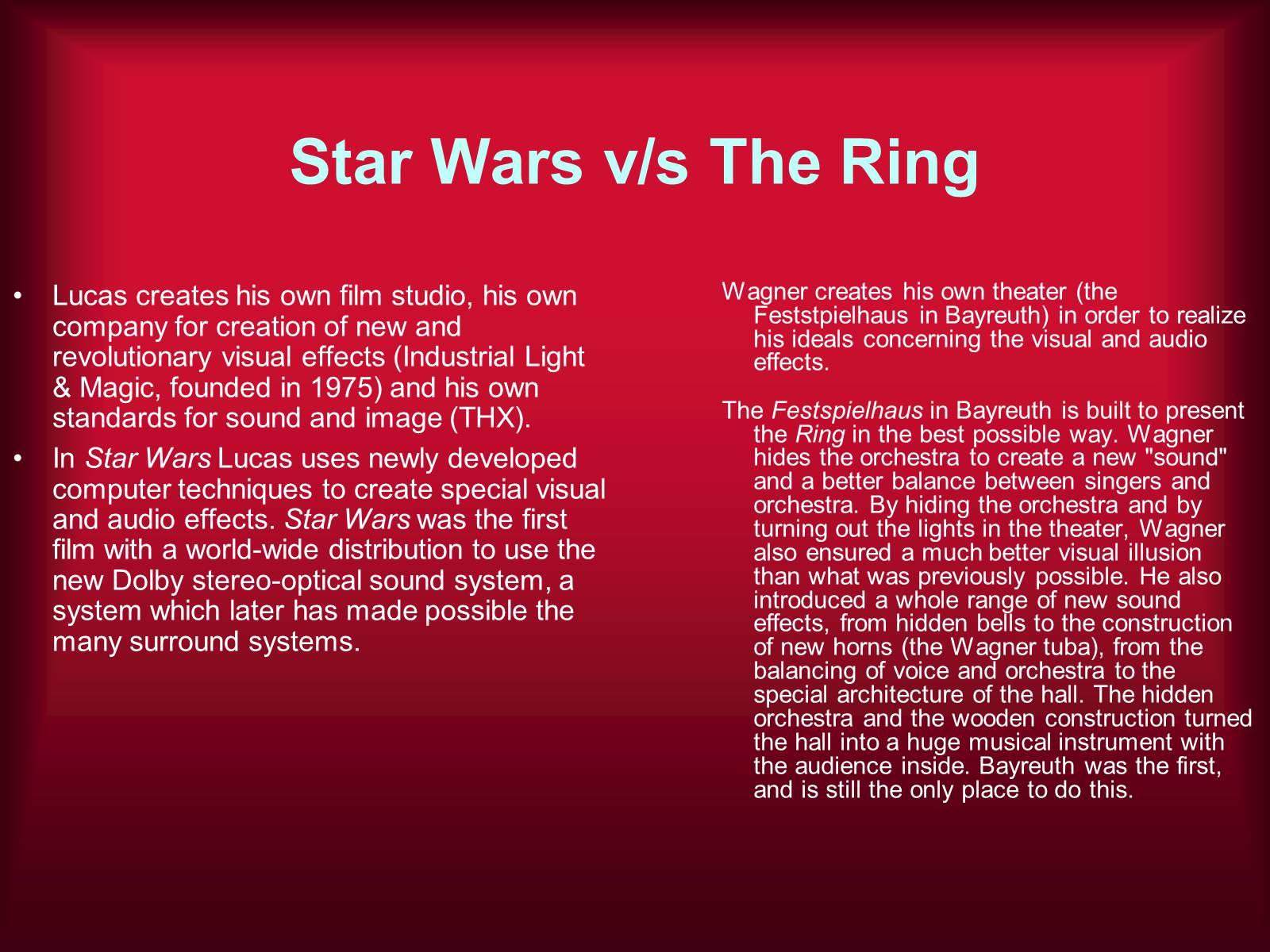
Star Wars v/s The Ring
Lucas creates his own film studio, his own company for creation of new and revolutionary visual effects (Industrial Light & Magic, founded in 1975) and his own standards for sound and image (THX).
In Star Wars Lucas uses newly developed computer techniques to create special visual and audio effects. Star Wars was the first film with a world-wide distribution to use the new Dolby stereo-optical sound system, a system which later has made possible the many surround systems.
Wagner creates his own theater (the Feststpielhaus in Bayreuth) in order to realize his ideals concerning the visual and audio effects.
The Festspielhaus in Bayreuth is built to present the Ring in the best possible way. Wagner hides the orchestra to create a new "sound" and a better balance between singers and orchestra. By hiding the orchestra and by turning out the lights in the theater, Wagner also ensured a much better visual illusion than what was previously possible. He also introduced a whole range of new sound effects, from hidden bells to the construction of new horns (the Wagner tuba), from the balancing of voice and orchestra to the special architecture of the hall. The hidden orchestra and the wooden construction turned the hall into a huge musical instrument with the audience inside. Bayreuth was the first, and is still the only place to do this.
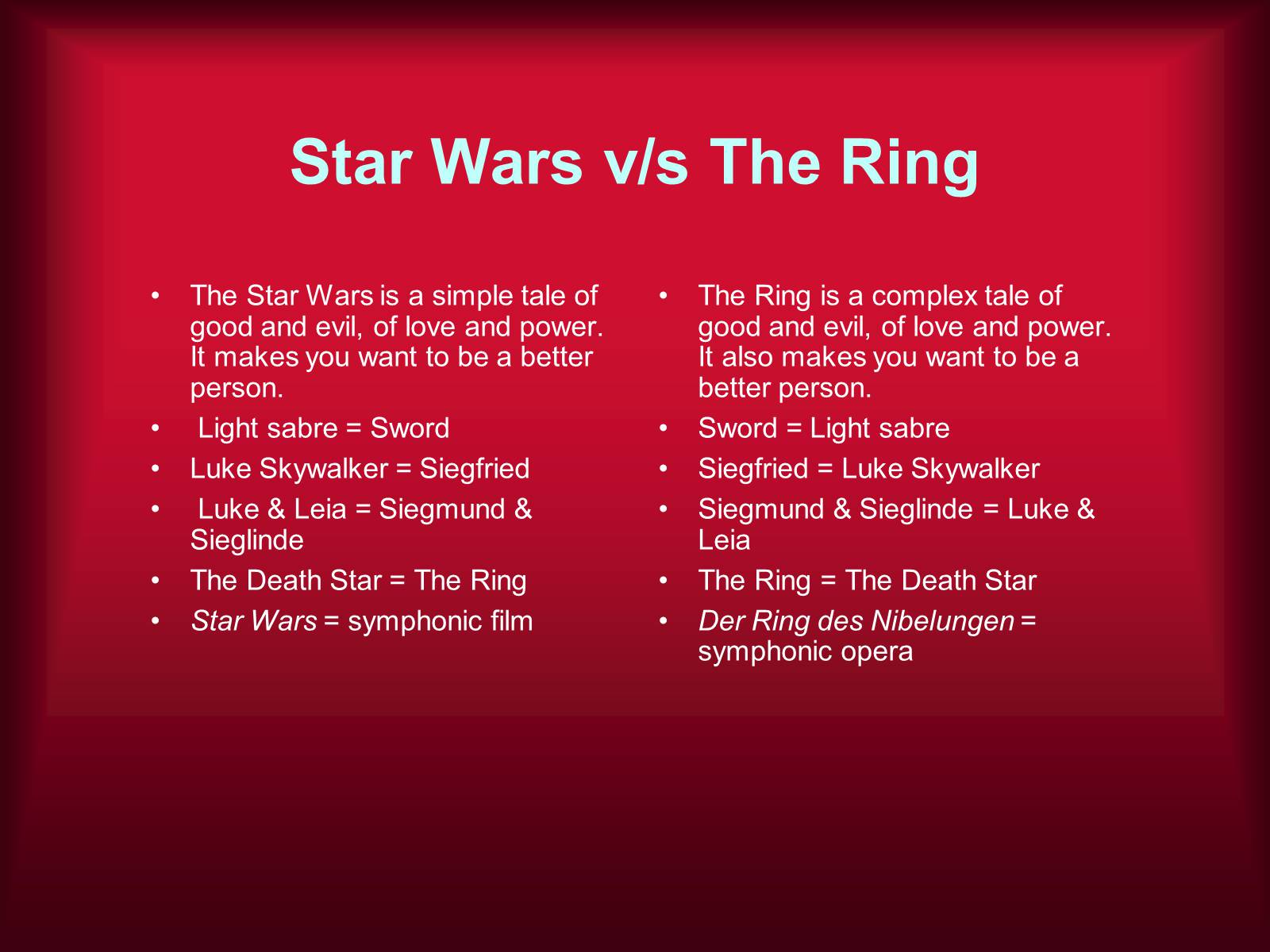
Star Wars v/s The Ring
The Star Wars is a simple tale of good and evil, of love and power. It makes you want to be a better person.
Light sabre = Sword
Luke Skywalker = Siegfried
Luke & Leia = Siegmund & Sieglinde
The Death Star = The Ring
Star Wars = symphonic film
The Ring is a complex tale of good and evil, of love and power. It also makes you want to be a better person.
Sword = Light sabre
Siegfried = Luke Skywalker
Siegmund & Sieglinde = Luke & Leia
The Ring = The Death Star
Der Ring des Nibelungen = symphonic opera
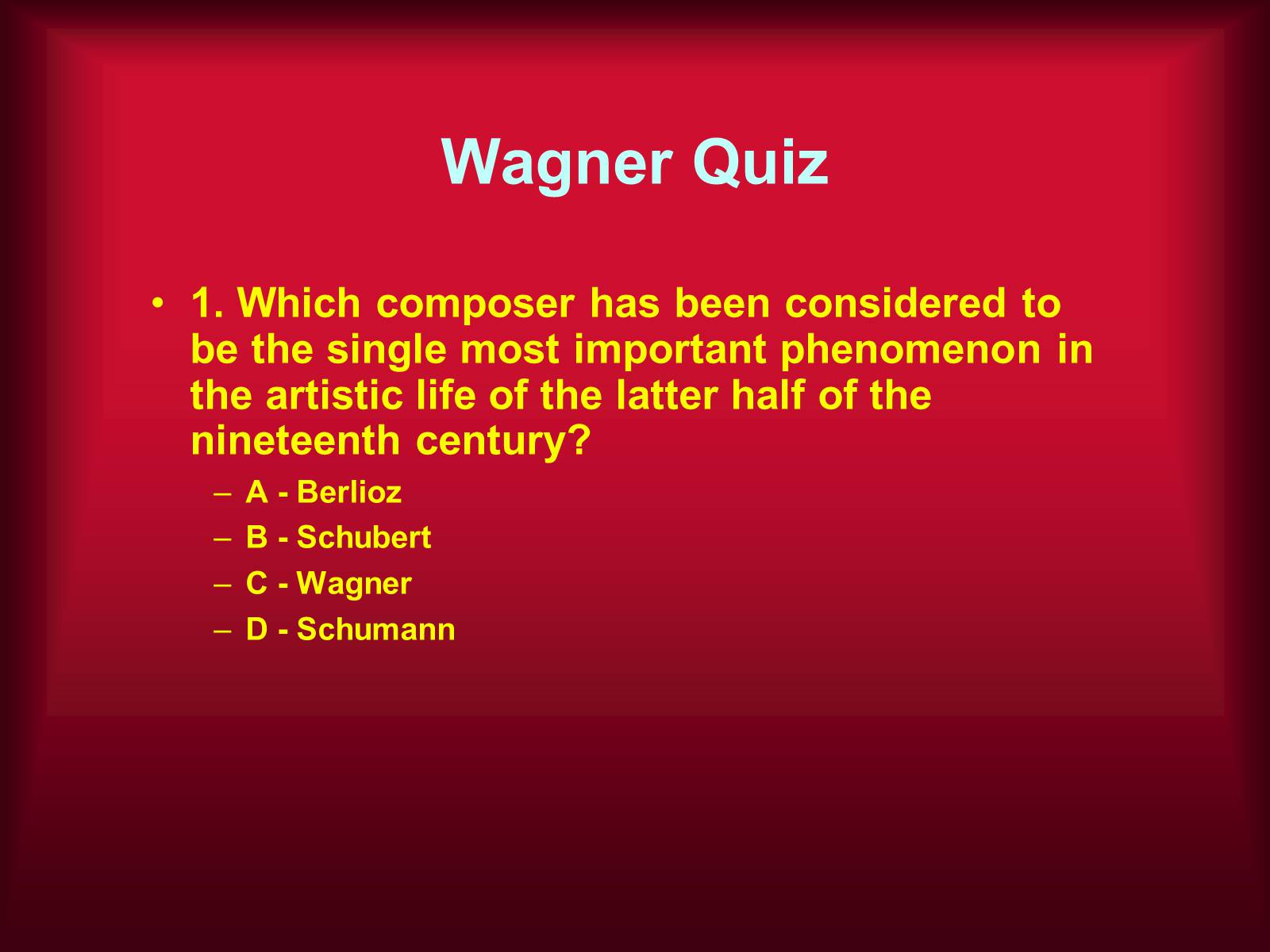
Wagner Quiz
1. Which composer has been considered to be the single most important phenomenon in the artistic life of the latter half of the nineteenth century?
A - Berlioz
B - Schubert
C - Wagner
D - Schumann
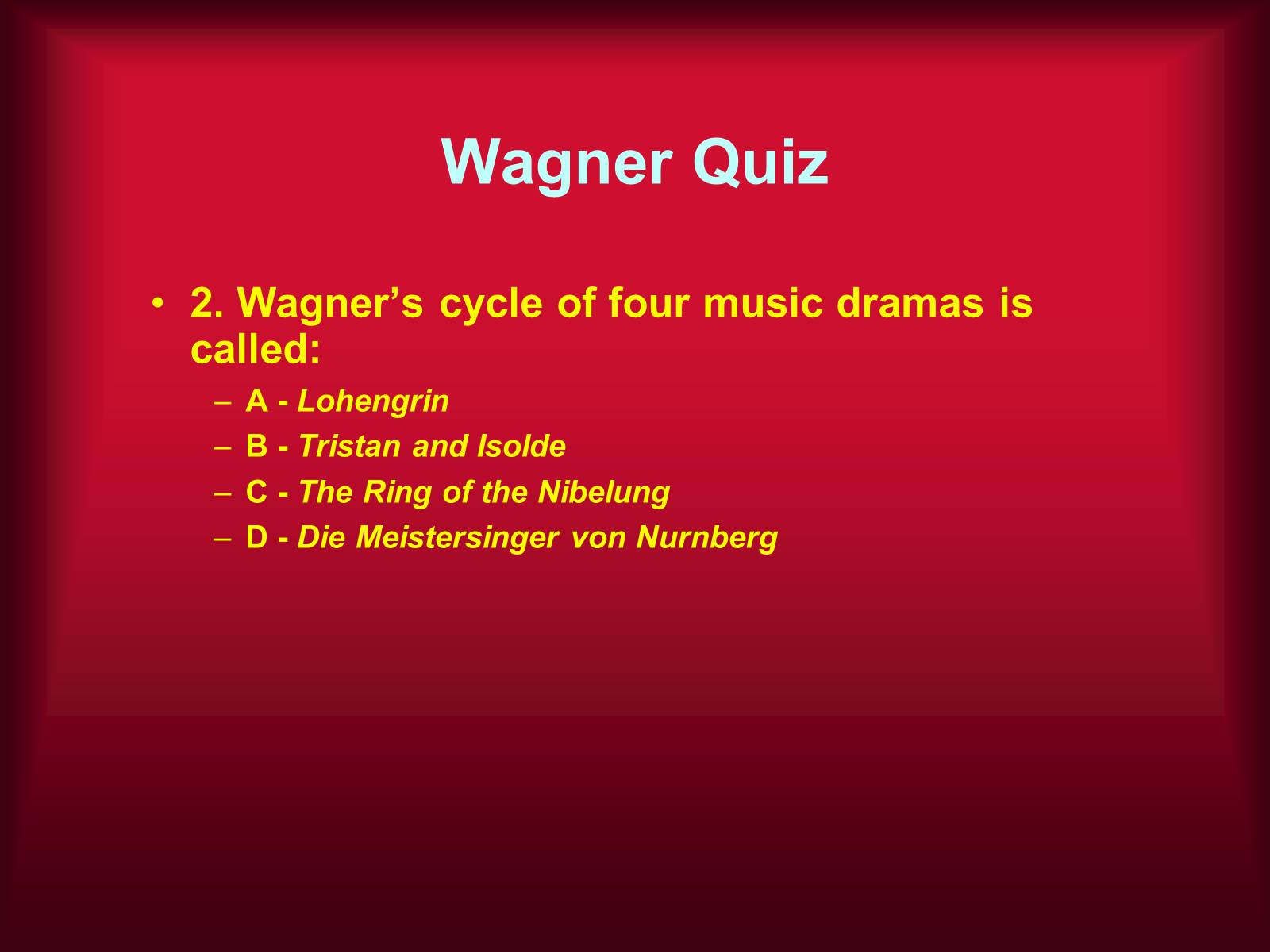
Wagner Quiz
2. Wagner's cycle of four music dramas is called:
A - Lohengrin
B - Tristan and Isolde
C - The Ring of the Nibelung
D - Die Meistersinger von Nurnberg
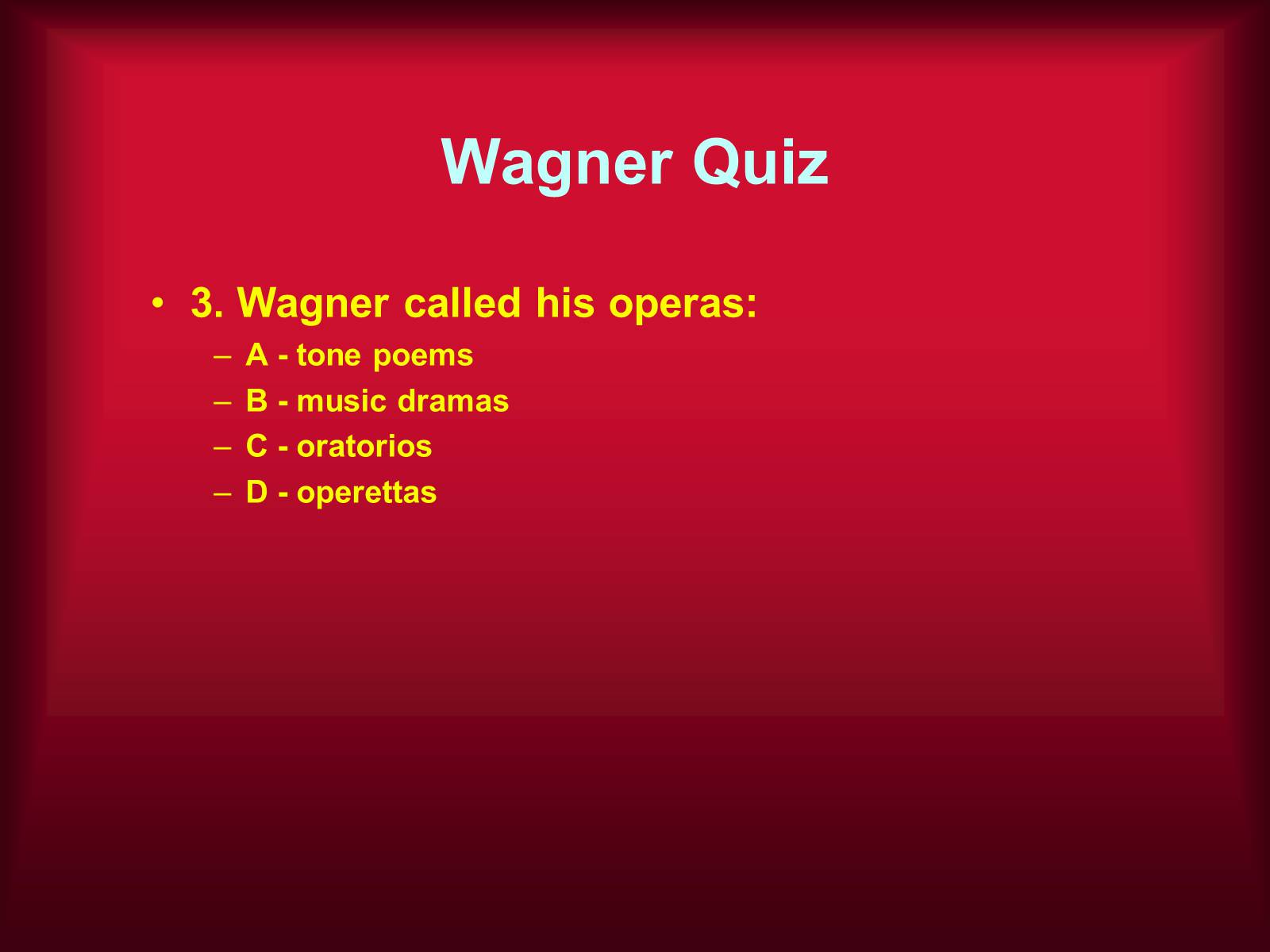
Wagner Quiz
3. Wagner called his operas:
A - tone poems
B - music dramas
C - oratorios
D - operettas

Wagner Quiz
4. The principal themes in Wagner's operas, which recur throughout a work and carry specific meanings, are called:
A - libretti
B - leitmotifs
C - motives
D - fixed ideas
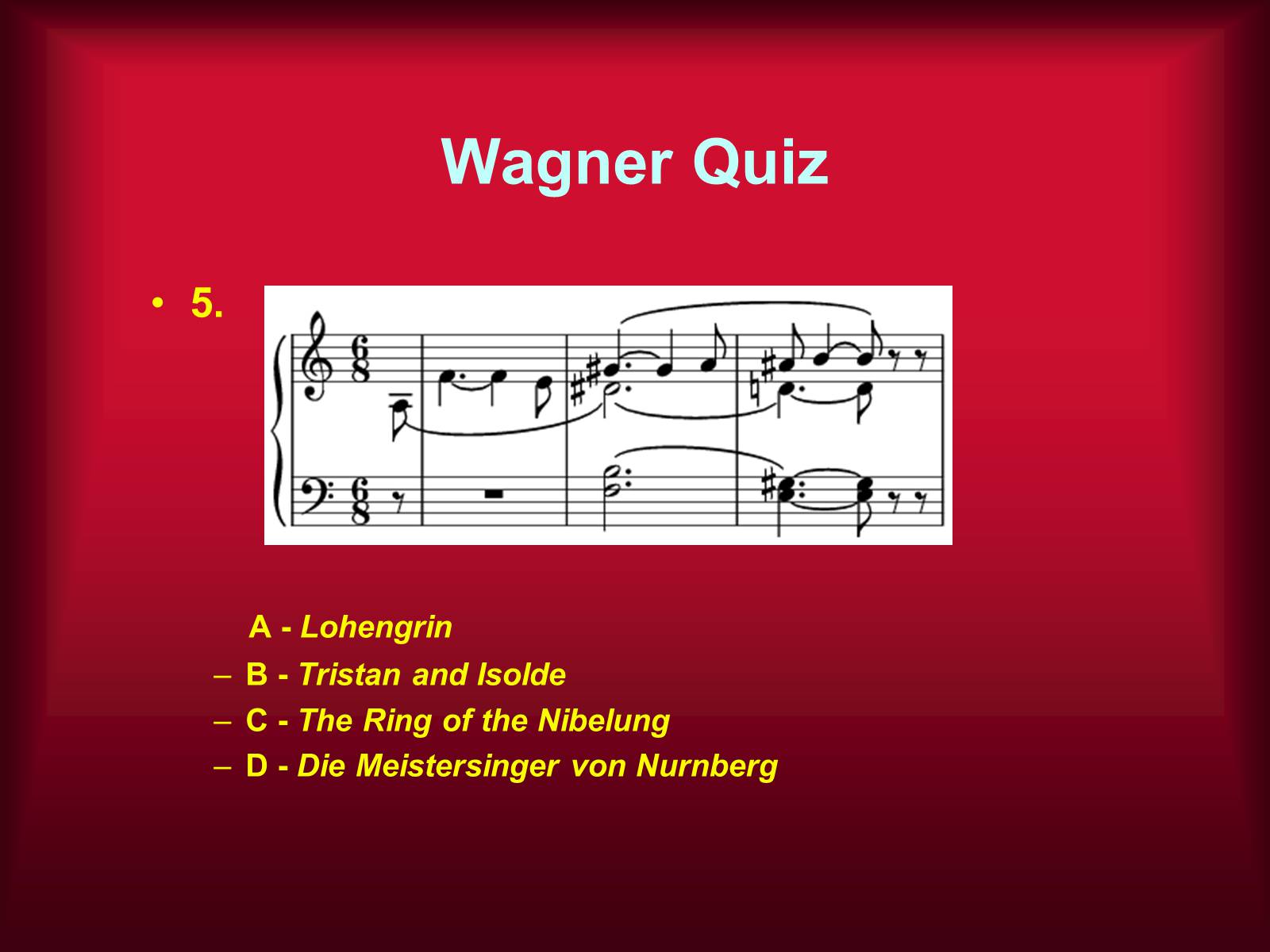
Wagner Quiz
5. A - Lohengrin
B - Tristan and Isolde
C - The Ring of the Nibelung
D - Die Meistersinger von Nurnberg